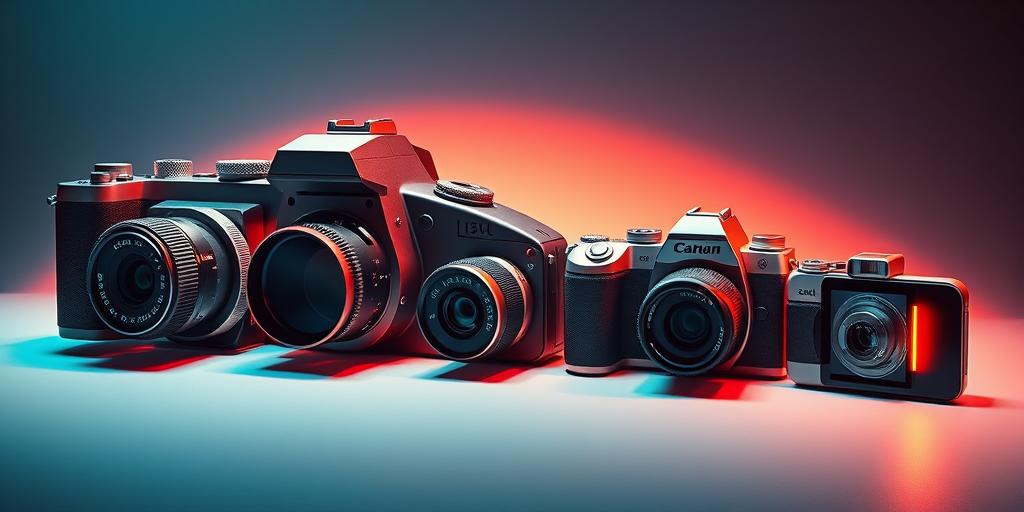Revisiting the First Digital Cameras That Changed Photography
Did you know that the first digital cameras were the size of a refrigerator? It’s true! Before sleek smartphones and pocket-sized DSLRs revolutionized photography, the journey began with bulky, expensive machines that laid the foundation for the digital photography we know and love today. This isn’t just some obscure tech history lesson; understanding the genesis of the digital camera helps us appreciate the incredible innovation that has since miniaturized this technology, improved image quality dramatically, and made it accessible to billions. Prepare to be amazed as we journey back to the dawn of the digital age and revisit the groundbreaking innovations that first made digital cameras a reality.
The Dawn of Digital: Early Experiments and Technological Hurdles
The earliest forerunners to the digital cameras we use today weren’t designed for the average consumer; they were largely experimental tools developed in research labs during the 1970s. These prototypes used charge-coupled devices (CCDs) – a technology originally designed for astronomical observation—to capture images electronically. Imagine the sheer technical prowess required to adapt this technology for capturing everyday scenes. These pioneers faced enormous challenges. Sensor technology was incredibly primitive by today’s standards. Early CCDs produced low-resolution, grainy images with limited dynamic range. Processing power was also painfully slow; converting raw image data into viewable pictures took an enormous amount of time. Storage was another major issue. Storing even a single image required significant memory, which was both expensive and bulky. The sheer cost of these early systems meant that they remained confined to research institutions and advanced laboratories, far removed from the market of everyday photographers.
Overcoming the Obstacles: A Technological Race
The 1980s marked a pivotal decade in the evolution of digital cameras. Scientists and engineers relentlessly pursued improvements to CCDs, increasing resolution, light sensitivity, and dynamic range. This was a period of intense innovation, fueled by a growing interest in digital image capture. Alongside advancements in sensor technology, there were equally impressive strides in image processing and data storage. The development of faster microprocessors drastically reduced image processing time. The emergence of more compact and affordable hard drives created solutions for storing the increasing volumes of digital image data. All these advances propelled digital cameras further towards a viable commercial product.
The First Commercially Available Digital Cameras
The late 1980s and early 1990s witnessed the arrival of the first commercially available digital cameras, marking a watershed moment in photography. These early models were still far from the sleek devices we know today. They were often large, expensive, and offered relatively low resolution. However, they demonstrated the potential of digital photography to a broader audience and helped pave the way for future innovations. Early adopters included professionals in fields such as law enforcement and photojournalism, who recognized the immediate benefits of digital image capture, despite the inherent limitations of the technology.
Key Models and Their Impact
Several significant digital cameras emerged during this period, each contributing to the technology’s advancement. One notable example was the Kodak DCS 100, a significant milestone in the industry, even though its high cost initially limited its adoption. It demonstrated what was achievable, paving the way for cheaper and better versions. The development of these early digital cameras sparked intense interest and investment within the photography industry, signaling the beginning of a fundamental shift towards a new age of digital photography.
The Rise of Digital and the Demise of Film
The transition from film to digital photography wasn’t instantaneous. Film photography retained its loyal following for many years, particularly amongst purists who valued the unique aesthetic and tactile experience. However, the advantages of digital photography—instant feedback, easy editing, cost-effectiveness in the long run—gradually proved irresistible. The improvement in sensor technology, combined with increasingly affordable storage and computing power, accelerated the adoption of digital cameras by consumers across all demographics.
Digital’s Expanding Reach: Smartphones and Beyond
The integration of digital cameras into smartphones proved to be a game-changer. The ubiquity of smartphones, combined with the continuous improvement in camera technology, led to digital photography becoming a fundamental part of everyday life. What was once exclusive to professionals and enthusiasts became a readily available tool for everyone. This shift not only democratized photography, but also resulted in an explosion of digital imagery and a dramatic change in how people capture and share moments in their lives. We’ve come a long way from bulky, expensive cameras! Today’s technology offers high-resolution images, amazing processing capabilities, and more.
The Legacy of the First Digital Cameras
The first digital cameras, despite their limitations, represent a remarkable achievement in technological innovation. Their introduction launched a revolution in photography, leading to a world where images can be instantly captured, shared, and manipulated with unparalleled ease. Their legacy extends far beyond their original purpose. The fundamental principles of those early digital cameras are still at the heart of the technology that drives today’s most advanced cameras and smartphones. Understanding this history highlights the sheer speed of technological progress that continues to shape the world of imaging. The journey from the bulky and expensive first digital cameras to the sleek smartphones with powerful cameras that we have today truly represents a remarkable feat of engineering and innovation.
Ready to dive deeper into the captivating world of photography history? Explore more fascinating facts and insights and expand your knowledge!













